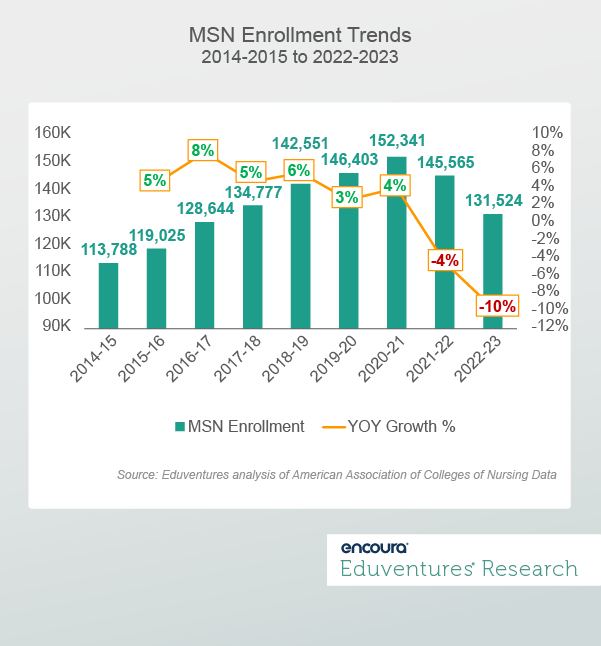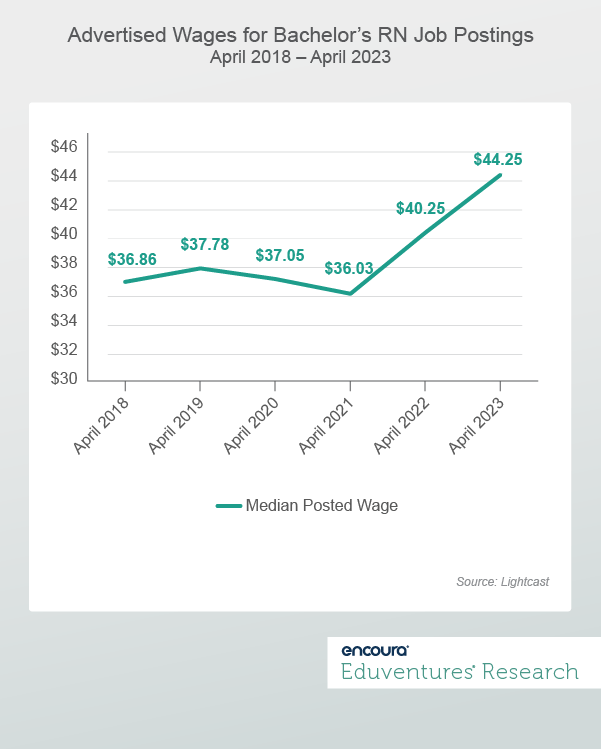Perhaps no other profession received as much attention during the pandemic as nursing did. Whether providing care, education, or emotional support to patients and their families, these duties were put to the test over the last three years as incredible stressors were placed on our healthcare system.
A recently published Eduventures report provides an update on the Bachelor of Science in Nursing (BSN) market, detailing that the 2022-2023 academic year saw the first entry-level BSN enrollment decline in many years – a critical development given that nursing has consistently been the most popular major for traditional-aged undergraduates. That report made us ask, ”What does the latest data tell us regarding the performance of the Master of Science in Nursing (MSN) market?”
Up and Then Down
Simply put, after years of strong growth, the pandemic’s effect on the MSN market is quite shocking. After growing by 34% from 2014 to 2021, overall MSN enrollment declined by 14% over the last two years with year-over-year growth reaching -10% in the 2022-2023 academic year.
MSN enrollment and year-over-year growth are shown in Figure 1.

The Nurse Practitioner (NP) MSN field, the largest MSN specialization with 63% of MSN enrollment, follows the same trend: a 4% decline in 2021-2022 followed by a 10% decline in 2022-2023. Critically, this market also saw an increase in programs over this time. This means that amid the enrollment decline, the market became less productive, dropping from 239 average provider enrollment in 2020-2021 to 202 in 2022-2023.
Additionally, overall MSN enrollment can be broken down into two segments: post-licensure and direct entry:
- Post-licensure MSN programs, designed for registered nurses (RNs) seeking to become advanced practice nurses, represented 93% of the market in 2022-2023 and reported 15% enrollment decline over the last two years.
- Direct-entry programs, while much smaller (just 7% of the MSN market) and designed for non-nursing bachelor’s holders seeking to change careers, saw a 6% enrollment bump from 2020-2021.
Forces Behind the Decline
That last bit of analysis is key to understanding current market challenges. The MSN market for RNs, which is also the overwhelming majority of the market (93%), is down, while the market for non-RNs is up. Why?
Well, we know that the pandemic introduced extreme stressors on the nursing workforce, and recent data shows that some nurses have acted by leaving the profession:
- Burnout. Last Spring, the American Nurses Foundation released findings from its impact survey assessing COVID-19’s effect on nurses two years into the pandemic. Its results were worrisome, particularly for younger nurses. For example, while 30% of all nurses said they were “not emotionally healthy” or “not at all emotionally healthy,” this figure jumped to 46% for nurses under 25 years of age. In another example, when asked to consider the future of the nursing profession, two-out-of-three nurses under 35 reported feeling burned out, compared to one-out-of-three nurses 55 or older.
- Career Switching. A study from the National Council of State Boards of Nursing, just published in April 2023, found that “approximately 100,000 registered nurses left the workforce during the COVID-19 pandemic in the past two years due to stress, burnout, and retirements.” The report also found that almost 800,000 more registered nurses reported an intent to leave the workforce by 2027 due to stress, burnout, and retirement (24% of which were under the age of 40).
This suggests that pandemic-induced pressures have indeed negatively affected the post-licensure MSN market. With younger RNs burning out at high rates, and a quarter of young RNs considering leaving the profession over the next four years, MSN investment has likely been pushed to the backburner or removed from the equation altogether.
With more nurses leaving the profession, the demand for bachelor’s educated nurses is through the roof. Consider that in April 2018, there were 39,484 unique monthly job postings for RNs with a bachelor’s degree. Jump to April 2023 and unique monthly postings for this group stood at 65,212 – a 65% increase. This increased demand can also be seen in wage trends via job postings as detailed in Figure 2.

Since April 2018, advertised median wages for bachelor’s educated RNs grew from $36.86 to $44.25 – a 20% increase.
While many RNs pursuing an MSN are indeed seeking opportunities to specialize in a field, increase professional responsibilities, and become advanced practice RNs, the current labor market appears to be weakening the incentive to get another credential right now.
The Bottom Line
For schools already active in the MSN market, the last two years represent a change from the prior period of uninterrupted and strong enrollment growth. The effects from the pandemic took a toll on the nursing workforce and a tight labor market has reduced the incentive for registered nurses to acquire another credential if pay was the motivating factor. A nursing shortage that was already underway and appears to be worsening suggests that this will be a long-term issue.
For schools actively considering MSN market entry, the once strong opportunity has lost its shine – at least for now.
Compounding the factors above, the National Organization of Nurse Practitioner Faculties issued a statement in April 2023 reaffirming the organization’s 2018 stance for transitioning all entry-level nurse practitioner programs to the Doctor of Nursing Practice (DNP) degree without a master's degree option by 2025. While no official changes have been made by accrediting bodies, this continued drumbeat could eventually make the MSN a less appealing option for prospects.
July 17-19, Nashville, TN
Join us in Nashville this July for a professional development conference focused directly on your most pressing enrollment challenges. Educational tracks include:
- Admission and Marketing Best Practices
- Excellence in Test Optional Practice
- Diversity, Equity, and Access
- SEM Planning and Leadership
The Program Strength Assessment (PSA) is a data-driven way for higher education leaders to objectively evaluate their programs against internal and external benchmarks. By leveraging the unparalleled data sets and deep expertise of Eduventures, we’re able to objectively identify where your program strengths intersect with traditional, adult, and graduate students’ values, so you can create a productive and distinctive program portfolio.

